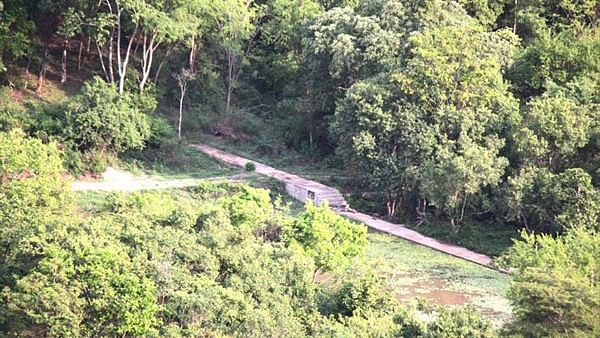
Bannerghatta National Park (BNP)
Credit: bannerughattabiopark.org/gallery
Amidst the concrete jungle of bustling Bengaluru thrives the Bannerghatta National Park (BNP). This green oasis is often confused with the Biological Park, which houses the zoo and safari.
The National Park is a protected, restricted forest area dedicated to conservation. This oxygen factory near the cosmopolitan hubbub is home to panthers, elephants, sloth bears, spotted deer, grey langoors, bonnet macaques, wild boars, jackals, reptiles, and various bird species. Occasional sightings of tigers indicate a thriving ecosystem. Yet, this summer witnessed a rise in human-wildlife conflicts in BNP.
The Karnataka Forest Department established the BNP in 1974. Initially spanning 106.83 km² with two reserved forests in Bengaluru Urban and Bengaluru Rural, it has expanded to 260.51 km² with 13 reserved forests scattered across Bengaluru Urban, Bengaluru Rural, and Ramanagara districts.
The park has four wildlife ranges: Anekal, Bannerghatta, Harohalli, and Kodihalli. The forests are primarily scrub-type, with mixed dry deciduous patches in the sheltered valleys and rocky terrain.
However, the expanding Bengaluru and growing human interference in BNP are matters of concern. Urbanisation indirectly causes forest loss as urban space expands over crop-land areas.
This crop-land expansion often leads to the conversion of natural regions such as lakes, riverbeds, and forests. Interestingly, the agricultural clearing of forests due to urban expansion into previously agrarian land is often more extensive than the original area taken over by urbanisation. When humans encroach on the forest and its periphery, wild habitats are lost, leading to wild animals attacking humans. It is a vicious cycle.
Additionally, peripheral villages and tribal enclaves graze cattle on the BNP forest fringes. Cattle destroy native vegetation, overgraze, and degrade forest land, resulting in a shortage of food for wild herbivores. Tourism, leisure spots, resorts, and residential developments have proliferated since liberalisation, shrinking the deciduous cover to half its original size.
Temples inside BNP attract devotees, and the festive inflow poses severe logistical challenges for park officials. Littering, improper waste disposal, crowd control, and animal movement tracking cause habitat degradation and disturb wildlife. Such uncontrolled human-wildlife interactions have disastrous consequences.
The drying up of the water sources is further exacerbated by rampant waste dumping and burning. Natural or human-induced forest fires destroy flora and fauna. Vehicular movement and unchecked tourism worsen trends of human-wildlife conflict.
Wildlife in BNP depends on the quantity, quality, and distribution of five essential habitats: air, food, water, cover, and space. Encroachment on these habitats pushes wildlife into crisis, leading to a snowballing series of events. Wild species threaten human habitats, resulting in a series of human-wildlife conflicts and chaos. BNP is home to many Asiatic elephants with vast breeding grounds and food and water resources.
However, roadways, tourism, and residential expansion disrupt their habitat. Man-made obstacles hinder their free movement. Frustrated and stressed, they venture into outlying villages, raid crops, and ruin livelihoods. Elephants are also in danger of being electrocuted by electrical lines or barriers.
Terrified villagers sometimes provoke reprisals against the elephants, further intensifying the conflict. There have been cases of leopards attacking cattle and stray dogs, even though these are not their natural diets. Cases of gaurs destroying crops and posing a threat
to farmers have been reported. Bear sightings are also being documented.
BNP is a beacon of hope for flora and fauna, as well as for humans living on its fringes. It is about protecting wildlife and maintaining a delicate
balance between animal and forest conservation and human development.
The Karnataka Forest Department and NGOs work to create awareness and conduct sensitization programmes about BNP’s rich biodiversity for villagers, and others. The efforts of Arocha India are worth mentioning. They work on securing the elephant corridor and educating stakeholders about the need for wildlife conservation. Arocha India fosters generational forest knowledge in protection and conservation activities. NGOs and ASHA workers call for volunteers to help with crowd management during festivals in the temples inside BNP. They carry out anti-snare drives in collaboration with the forest department. Several initiatives have been taken to curb wildfires and sensitise local communities about waste disposal and incineration.
Every step we take to safeguard this wildlife paradise is a stride towards the betterment of mankind. Commitment to protecting such places is akin to casting pebbles into still waters. The ripples created extend far beyond what our senses can fathom, fostering the BNP ecosystem.
(Meet Kumar and Vasu Arora are students, and Sreemoyee Sarkar is an
assistant professor at the School of Social Sciences, Christ (deemed to be
university), Bengaluru)